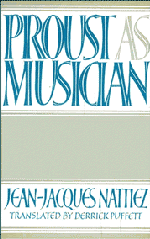Book contents
- Frontmatter
- Contents
- Preface to the English edition
- Translator's note
- 1 Introduction: Beyond the ‘little phrase’
- 2 Parsifal as redemptive model for the redemptive work
- 3 Music as redemptive model for literature
- 4 From Vinteuil to Schopenhauer
- 5 In conclusion: Quest for the essence and denial of the origin
- Appendix: Passages from A la recherche translated in the text
- Notes
- References
- Index
2 - Parsifal as redemptive model for the redemptive work
Published online by Cambridge University Press: 27 October 2009
- Frontmatter
- Contents
- Preface to the English edition
- Translator's note
- 1 Introduction: Beyond the ‘little phrase’
- 2 Parsifal as redemptive model for the redemptive work
- 3 Music as redemptive model for literature
- 4 From Vinteuil to Schopenhauer
- 5 In conclusion: Quest for the essence and denial of the origin
- Appendix: Passages from A la recherche translated in the text
- Notes
- References
- Index
Summary
In The Captive there is a passage which is quite extraordinary, not only because of its immense beauty but also because it is the only place in the whole of A la recherche where the Vinteuil Sonata is explicitly compared to a real work. ‘Comparison’ here must be taken to mean not only the artistic analogy that Proust wishes to stress but also the physical proximity through which he makes it manifest:
Could life console me for the loss of art? Was there in art a more profound reality, in which our true personality finds an expression that is not afforded it by the activities of life? For every great artist seems so different from all the rest, and gives us so strongly that sensation of individuality for which we seek in vain in our everyday existence! Just as I was thinking thus, I was struck by a passage in the sonata. It was a passage with which I was quite familiar, but sometimes our attention throws a different light upon things which we have known for a long time and we remark in them what we have never seen before. As I played the passage, and although Vinteuil had been trying to express in it a fancy which would have been wholly foreign to Wagner, I could not help murmuring ‘Tristan,’ with the smile of an old family friend discovering a trace of the grandfather in an intonation, a gesture of the grandson who has never set eyes on him.[…]
- Type
- Chapter
- Information
- Proust as Musician , pp. 12 - 33Publisher: Cambridge University PressPrint publication year: 1989



